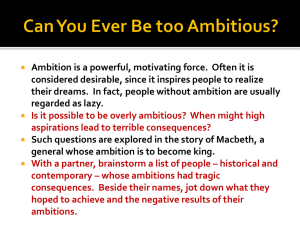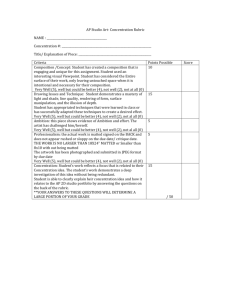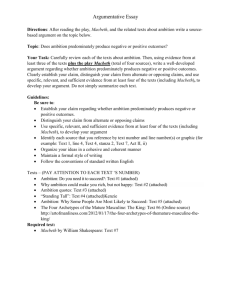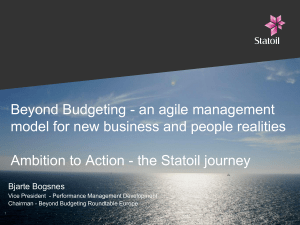Employee Engagement & Happiness: Personal Balanced Scorecard
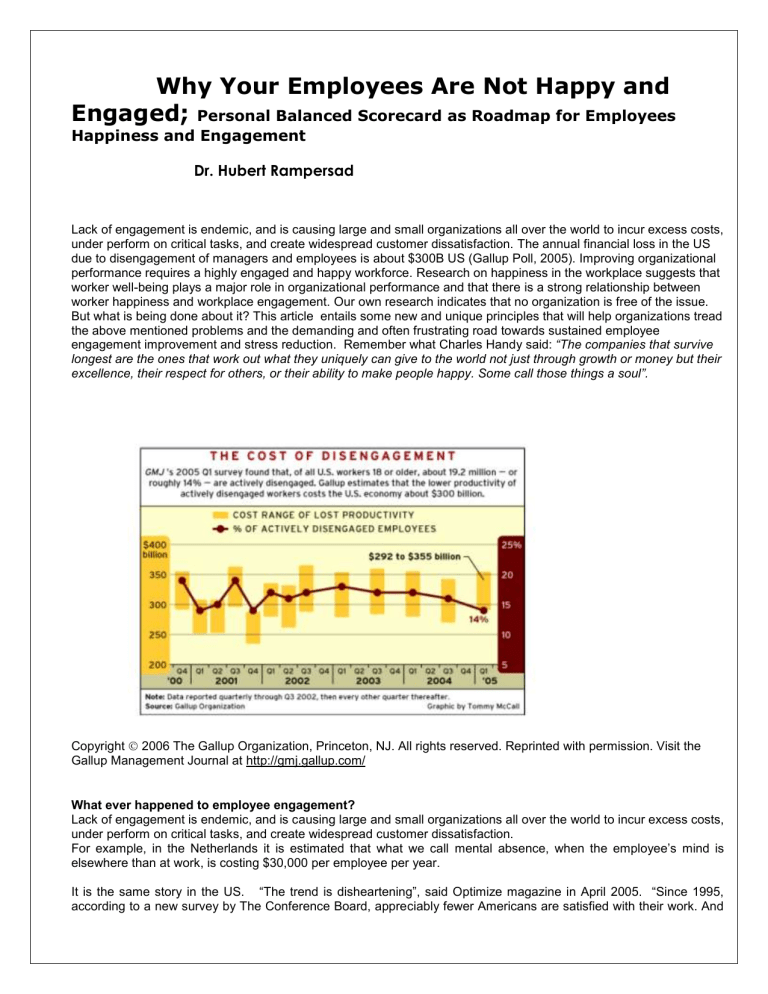
Why Your Employees Are Not Happy and
Engaged;
Personal Balanced Scorecard as Roadmap for Employees
Happiness and Engagement
Dr. Hubert Rampersad
Lack of engagement is endemic, and is causing large and small organizations all over the world to incur excess costs, under perform on critical tasks, and create widespread customer dissatisfaction. The annual financial loss in the US due to disengagement of managers and employees is about $300B US (Gallup Poll, 2005). Improving organizational performance requires a highly engaged and happy workforce. Research on happiness in the workplace suggests that worker well-being plays a major role in organizational performance and that there is a strong relationship between worker happiness and workplace engagement. Our own research indicates that no organization is free of the issue.
But what is being done about it? This article entails some new and unique principles that will help organizations tread the above mentioned problems and the demanding and often frustrating road towards sustained employee engagement improvement and stress reduction. Remember what Charles Handy said: “The companies that survive longest are the ones that work out what they uniquely can give to the world not just through growth or money but their excellence, their respect for others, or their ability to make people happy. Some call those things a soul”.
Copyright
2006 The Gallup Organization, Princeton, NJ. All rights reserved. Reprinted with permission. Visit the
Gallup Management Journal at http://gmj.gallup.com/
What ever happened to employee engagement?
Lack of engagement is endemic, and is causing large and small organizations all over the world to incur excess costs, under perform on critical tasks, and create widespread customer dissatisfaction.
For example, in the Netherlands it is estimated that what we call mental absence, when the empl oyee’s mind is elsewhere than at work, is costing $30,000 per employee per year.
It is the same story in the US. “The trend is disheartening”, said Optimize magazine in April 2005. “Since 1995, according to a new survey by The Conference Board, appreciably fewer Americans are satisfied with their work. And
it's not just one or two facets of work that's making them cranky —pick a topic, and there's dissatisfaction. Take vacation policies. In 1995, 56% were satisfied. Ten years later, the figure is 51%. Satisfaction with physical facilities is down to 52% from 56%. Age and income don't matter either; the trend is all downward.”
The average U.S. worker wastes more than two hours a day, and that's not including lunch, according to a new Web survey by America On-line and Salary.com. That means companies spend as much as $759-billion (U.S.) on salaries annually for which they receive no apparent benefit, the research found.” Our own research indicates that no organization is free of the issue. But what is being done about it?
The premise of this article is that self-examination is the only road to sustaining employee engagement. In fact, it is the only road for gaining it in the first place.
Enter the Personal Balanced Scorecard
The Personal Balanced Scorecard (PBSC) is a new personal approach to non-work and work performance founded on self-examination. The thinking process and mind-set change that provide its basis are designed to prepare you for action and, just as important, for inner involvement in your work. The two together foster resolution, passion and energy. The underlying principle is quite straightforward. By writing down your PBSC, you put a mirror in front of you.
As you acquire insights, you become more pro-active and self-assured, and find you will learn faster and think more clearly. The PBSC is a scorecard of your work and non-work, encompassing your personal mission, vision, key roles, critical success factors, objectives, performance measures, targets and improvement actions, divided along four perspectives: internal, external, knowledge & learning, and financial. It draws on what is important to you, such as your personal habits, skills and behaviors. These are pointed to your personal well-being and success in society.
Your personal ambition (personal mission, vision, and key roles) enables you to express your personal intentions, identity, ideals, values, and driving force, as well as gain more insight into yourself.
The elements of the PBSC are divided among the following four perspectives:
1. Internal: your physical health and mental state. How can you control these in order to create value for yourself and others? How can you remain feeling good in your skin at work as well as in your spare time?
2. E xternal: relations with your spouse, children, friends, employer, colleagues, and others. How do they see you?
3. Knowledge and learning : your skills and learning ability. How do you learn, and how can you remain successful in the future?
4. Financial: financial stability. To what degree are you able to fulfill your financial needs?
These four fundamental perspectives form an integral part of your personal ambition, and together with your personal critical success factors form the bridge between personal ambition (long term) and personal objectives, performance measures, targets and improvement actions (short term). The PBSC can be defined as follows in formula form:
PBSC = personal mission + vision + key roles + critical success factors + objectives + performance measures + targets + improvement actions (divided along the four perspectives: internal, external, knowledge & learning, and financial).
Figure 1 shows the questions prompted by the framework, which form the basis of the PBSC.
2
Figure 1: PBSC Framework © Hubert Rampersad
Practical Case; The Personal Balanced Scorecard of Jack Johnson
To illustrate the PBSC, let’s consider the personal ambition of Jack Johnson. He is the owner and CEO of a small management consulting firm in the UK, a workaholic born in 1953. He has been hearing frequent complaints from customers about his unhelpful attitude and poor performance. His wife and children have also not been very happy with Jack because of a lack of balance between work and private life that has left them with less and less attention from him as he fights fires at work. He thinks he is engaged because he is always working, either with his clients or his family. However, he is starting to recognize that he is not as engaged as he thinks he is, judging by the diminishing results he is experiencing. In fact, a perception gap like this, that confusing effort input and results output, is often a feature of employee disengagement. Jack Johnson’s personal ambition is shown in the boxed text below.
The translation of his personal ambition into action (the complete PBSC) can be found in my new book " Personal
Balanced Scorecard; The Way to Individual Happiness, Personal Integrity and Organizational Effectiveness "
(Information Age Publishing Inc, USA, 20006).
Personal Ambition of Jack Johnson
Personal Mission
Enjoy the freedom to serve others and to create a world of love and empowerment.
Personal Vision
3
I want to fulfill my mission in the following way:
Earning the respect of my customers, colleagues, friends and loved ones
Continue to look for challenges in my work, accept them and enjoy doing so
Help organizations to be successful
Continue to further develop my skills and competencies, and learn continuously
Not act in conflict with my conscience
Continue to increase my inner strength and keep this in balance with my physical health
Achieve financial security
Personal Key Roles
In order to achieve my mission, the following key roles have top priority:
Spouse: A maximum fulfillment of what is important for my wife, based on love, faithfulness, support and unconditional trust
Father: Be an example for my children so that they treat themselves and the people around them with respect and give them the ability to make the right choices and take decisions
Consultant: Competent, honest, co-operative, and committed
Fellow man: Give and receive trust
Jack Johnson has started to formulate his PBSC, including both work and non-work explicitly in order to create a work-life balance. Already he is acting on his self-directed ideas and is no seeing significant improvements in how he serves others and in their satisfaction with the changes that are quite apparent.
Figure 2.: The PDAC Cycle (© Hubert Rampersad)
Implementing the Personal Balanced Scorecard, increasing engagement
4
The next step in the personal balanced scorecard process is implementing your formulated Personal Balanced
Scorecard (PBSC). This is necessary to let your awareness grow step-by-step, to continuously develop your skills, and to become more creative. I have introduced a new learning cycle to accomplish this, the Plan-Do-Act-Challenge cycle (PDAC cycle), to be followed continuously (see Figure 2 ).
To live in accordance with the PBSC and implement it according to the PDAC cycle, results in a cyclical learning and step-by-step process in order to increase happiness, self- awareness, self-regulation, empathy, enjoyment, fun and creativity, at work as well in your spare time. After all, when people are in control of their own actions and are free to face challenges, they tend to be happier. The PDAC-cycle consists of the following four phases (Rampersad, 2005):
Plan; Formulate or update your PBSC, which focuses on your work as well as on your spare time. Apply the introduced breathing and silence exercise to achieve this. This breathing exercise gives you more energy, which you need to transform your personal ambition into action (by way of personal objectives, performance indicators and targets), with purpose and resolution.
Do; Start with a simple objective from your PBSC with corresponding improvement action, keeping in mind the priorities that have been identified. Each morning as you rise, focus on a selected improvement action which you will strive to implement during the day. Execute the improvement action with emotional dedication, self-confidence, and willpower and concentrate on the action. This must be in concordance with your present skills. Submit yourself with courage to the related objective, even when you run into resistance. Root your good intentions with a trusted person
(spouse, friend, colleague or manager), who will ask questions and give you honest feedback. Doing is related to acting with purpose and to deliver efforts to realize your objective. Ask feedback often to the trusted person. This gives you the opportunity to measure the progress you have made. Start with habits, which restrict you, influence your life unfavorably, and deliver poor results.
Act; Check if the improvement action is working and take action when it is not. Review the results according to the defined personal performance measures and targets, measure your progress, and check to what extent you have realized your personal objectives. If you have not been able to realize your objective, start again. You will improve steadily as it becomes a habit to do good things right the first time and evaluate your PBSC each month with your trusted person. Think of three people who can act as your trusted person; who provide you with inspiration and motivation support for realization of your objectives and improvement actions. Plan to meet with each one of them regularly. Listen enthusiastically to them, brainstorm with them, and take their wise counsel. Develop your skills and competencies to achieve the objectives you selected. Recognize your responsibility to constantly develop yourself.
Implement the proven personal improvements, assess the personal results, document the lessons learned, and improve and monitor your actions and thinking continuously. Also think about bringing your personal ambition and your personal behavior in balance, which will result in influencing your ethical behavior. After a few weeks, you will notice small differences in yourself. In two months, the behavioral change will become firmly embedded. After five months, the important personal quality will be yours.
Challenge; Accept larger challenges by selecting a more difficult objective and corresponding improvement action from your PBSC and get on with it. Take your chance and be conscientious to choose a more challenging objective in line with your improved skills when the current improvement action starts being boring. Enjoy the pleasant experience and document what you have learned and unlearned during the execution of the improvement action. Refine it and review your PBSC regularly. The boxed text below shows some activities related to continuous personal improvement in accordance with the PBSC. We have found a direct correlation between these and an increase in engagement.
Sample Activities related to continuous personal improvement in accordance with the PBSC (Rampersad, 2005)
Formulate and study your PBSC and evaluate it regularly.
Evaluate the necessity of your personal growth and educate yourself continuously.
According to Einstein :” Education is what remains after one has forgotten what one has learned in school”.
Enter constantly into new challenges and develop your related skills.
Perform breathing and silence exercises every morning for about 20 minutes. This may later be expanded to 40-50 minutes a day. The breathing exercise gives you more energy, which you need to transform your personal ambition with purpose and resolution into action.
Share the work related elements of your PBSC also with your manager.
Implement your PBSC routinely on the basis of the PDAC cycle. Act with purpose and deliver efforts to realize your ambition.
Ask your manager, colleagues, co-workers, clients and others, in whom you trust, for feedback.
5
Evaluate the results of the PBSC implementation. Compare these with the personal performance measures and objectives in your PBSC.
Check if you have realized your personal objectives.
Adjust your PBSC continuously. It is a living document.
Evaluate your ethical behavior constantly on the basis of your PBSC
Make time available in your diary to continuously improve yourself, enter into new challenges and to assist others to improve themselves.
Develop your intuitive skills on the basis of your PBSC. To make decisions on the basis of intuition is quick, accurate and effective.
Be unselfish and a servant. Learn to give what you would like to have. Make service an important goal in your life.
Think of the continuous learning in accordance with the PDAC cycle as a challenge and, with this, increase your creativity continuously.
Measure constantly in order to make decisions based on facts.
Respect others, speak honestly and positively about them and judge them objectively.
Pay attention to your spiritual development in order to reach a higher level of self-consciousness.
Coach yourself on the basis of your PBSC and PDAC cycle and live in harmony with your formulated personal ambition.
Match your personal ambition with your personal ethical behavior, in order not to act in conflict with your conscience, and, because of this, influence your ethical behavior favorably. Try to become a better human being.
Celebrate your successes and enjoy the optimum experiences, you will acquire on the basis of this way of life.
Aligning Personal Ambition with Personal Behavior; Personal Integrity
The balance between personal ambition and personal ethical behavior is the next step towards lasting personal growth and reinforcing honesty and trustworthiness.
This balancing process is about the interaction between, on the one hand, your aspirations, intentions, purpose, principles, ethical standards, and values —in other words, your personal ambition—and, on the other hand, how others interpret you (your personal ethical behavior), see Figure 3 .
Figure 3: Aligning Personal Ambition with Personal Behavior
The central questions in this contemplative process are:
Do I act in accordance with my conscience?
6
Is there consistency between what I am thinking and what I am doing?
How do my ideals, ambitions, intentions, needs, and deepest desires fit my present actions?
Are my thoughts and my practices the same?
Do I act in accordance with my personal ambition?
Does my personal ambition reflect my desire to act ethically?
Are there contradictions in my personal ambition?
In what way does my behavior influence my views, and vice versa?
Engagement: Aligning Personal Ambition with Shared Ambition
The alignment of the personal ambition with the shared organizational ambition is central for the purpose of commitment, trust, inner involvement, stress and burnout reduction, stimulating enjoyment, active participation, motivation and empowerment of employees. It has to do with reaching a higher degree of match between personal and organizational objectives and mutual value addition, as shown in figure 4 . People do not work with devotion and do not spend energy on something they do not believe in or agree with. Clarity and uniformity of personal and organizational values and principles are, therefore, essential for the active involvement of people. Research has shown that when an individual has some input regarding the shared ambition that affects his or her work, the person will be more supportive, motivated, and receptive towards organizational change.
Figure 4: Match between Personal Ambition and Shared Ambition
Doing work that is interesting, exciting and a learning experience is typically a key personal driver. Experience teaches us that identification with the organization is the most important motive for employees to dedicate themselves actively to the organizational objectives and to maximize their human resource potential. People all have different personal values and principles that we must try to understand and link to the values of the organization.
Cementing sustained engagement: Ambition Meeting
Experience tells us that co-workers are often willing to work towards the goals of the organization and to work with dedication when there is a match between their personal ambition and the shared ambition of their organization. It is,
7
therefore, recommended to stimulate managers and employees to formulate their personal ambition and to let them reflect about the balance between their own personal ambition and the shared ambition. I, therefore, recommend introducing an ambition meeting within organizations between the line-manager or superior and his/her employees.
The ambition meeting is a periodical, informal, voluntary and confidential meeting of maximum one hour between linemanager and his/her em ployee, with the employee’s PBSC and the shared ambition as topics. It is recommended that this meeting is held structurally at least once per quarter, preferably more often. The results of these informal meetings are highly confidential and have to be kept out of the personnel file and not be used against the employee.
The manager functions as trusted person or informal coach. To be able to talk about the employee’s PBSC, one needs a confidential, informal and friendly atmosphere, an atmosphere of trust and open communication. This is essential, as human values will be discussed. Experience teaches us that this intimate atmosphere can be reached if the manager formulates his/her own PBSC beforehand and shares it with his/her co-worker. Also, the implementation of the employee’s PBSC comes up for discussion.
The following questions are central in the ambition meeting:
Does your personal ambition correspond with the shared ambition?
Can you identify yourself with the shared ambition? In doing this, do you feel personally involved and addressed by the shared ambition? Are your personal mission, vision, and key roles to be found in the shared ambition? If not, do they have to be expanded or adjusted? Are they acceptable? How can they flourish within the organization?
Is it possible that your personal ambition level or that of the organization should be lowered?
Do your personal values and principles match the organizational vision and core values? If they conflict, is leaving the best answer? Do your most important personal values do justice here? Which points in your personal ambition are strengthening to and which conflict with the shared ambition? Which ones are neglected?
Is there a win-win situation between your own interests and the ones of your organization?
Which skills do you need to be a pillar of the organization and thus realize the shared ambition? What do you want to gain yourself with this?
Are your developmental expectations in tune with those of the organization?
Do your job requirements match your capabilities and needs?
How does it go with the implementation of your PBSC? Did you reach your target? Could it be better? Where did it go wrong? What have you learned? What did you unlearn?
What motivates you? What de-motivates you?
Do you have ethical issues with aspects of the job?
Have you considered a job change because of this?
Aligning personal ambition with shared ambition deals with the mutual concordance of the Personal and
Organizational Balanced Scorecards or individual versus collective learning (see Figure 5 ).
8
Figure 5: Aligning Personal Ambition with Shared Ambition
This has an important impact on binding of the employees with the organization. It gives them the feeling that they count (attention), that they are appreciated, and that they make a useful and valuable contribution. The alignment of the personal ambition with the shared organizational ambition has to do with reaching a high degree of match between the PBSC and the OBSC, as shown in figure 6 . For greater detail, I refer you to my book Total Performance
Scorecard; Redefining Management to Achieve Performance with Integrity (Rampersad, 2003).
9
Figure 6 : Aligning PBSC with OBSC
Tackling lack of engagement
To what extent are the managers in your organization helping to improve engagement? Many CEOs and their team create disengagement by handing down a series of instructions without any regard for the poor recipient. Many supervisors feel obliged to pass these instructions on to their staff without thoroughly accepting them, or perhaps even thoroughly understanding them. Moreover, these supervisors are typically very uncomfortable in giving performance reviews, and their staff sensing this are also uncomfortable with the reviews.
In our consulting practice, we see many supervisors needing to take a crash course into the people aspects of To help address this gap, we offer four people-oriented strategic performance management principles that will help supervisors tread the demanding and often frustrating road towards sustained staff engagement improvement. These five principles are colored by own work in aligning people with organizational goals, and vice versa , in order to create a high performance culture. However, there is a valid reason for this – poor people alignment is , from our experience, the single biggest factor holding back organizations from moving to a high performance culture.
Principle1: Organizational performance is the sum of its individuals
Most organizations create the appearance of assigning performance activities to individuals, typically creating individual performance plans that have been cascaded down from organizational goals. For example, an organizational goal might be to improve group cash flow by 25% over the n ext year. The supervisor’s group might be assigned a subset of the organization’s objectives, supported by some uniquely departmental activities, and some shared with other groups. The hope is that if each individual in the group is assigned a portion of the overall goals, organizational results will materialize. Allocating tasks based only on the organization’s needs is an incomplete basis on which to ask the employee to act. It is a recipe for employee disengagement and underperformance.
Principle 2: Align goals between individuals and the organization
Our work in performance, scorecards, and organizational development has demonstrated quite clearly that aligning individuals’ personal goals with the goals of the organization translates into measurable and sustained performance improvement. Results are typically visible in metrics improvements such as in employee satisfaction and employee absenteeism. These in turn translate into growth in revenue, productivity and customer loyalty.
Principle 3: Take improvement actions, don’t just measure
While senior managers are paying increasing attention to engagement, there is so far little visible advance in engagement results. Part of the reason may be that many performance improvement programs tend to lose the focus on improvement actions and settle down into just measurement programs. In the aligned environment, metrics measurement is just the starting point – a prelude to developing improvement actions that work. To support a continuous performance improvement program, qualitative business metrics are required such as customer profitability, share of wallet and retention, appropriateness of recommendations to prospective customers, and perceived compatibility of frontline staff with customer goals. Employee metrics might focus on motivation measures such as absenteeism, team productivity, leadership quality, and employee satisfaction. In managing such metrics, the
CEO can suggest remedial actions by highlighting how well employees are functioning as teams, to what extent personal ambitions are compatible with organizational direction, and where the organization can move more quickly towards an environment of information-sharing and trust. Outcomes might include reducing employee disengagement costs as evidenced by sickness, mental absence, elevated error levels, and low satisfaction scores.
Principle 4: Implement continuous improvement, starting at the top
How should a CEO go about aligning people and organizational goals?
10
Begin at the leadership team’s own personal vision, roles and goals – and their alignment with those of the organization and vice versa. By working top-down initially, the aim is to tackle some of the most critical performance issues first.
Another good way to start is with an on-line survey of the existing knowledge and learning culture – what the organization does well along with potential barriers to engagement, teamwork, and productivity. The key is turning the survey results into a plan for what to do next, examining the implications of the survey results in order to provide actionable feedback. While defining and aligning individual goals has been proven to result in substantial organizational improvement, keeping that improvement is another matter. For sustainable improvement, it is necessary for the individuals to update their personal balanced scorecards regularly as a living document, as they make progress in acting on their personal plan. The CEO can either act as mentor in this or make sure trusted people take on this crucial role.
Conclusion
Traditional scorecard implementations tend to be insufficiently committed to learning and rarely take the personal ambitions of employees into account. Without a set of rules for employees that addresses continuous process improvement and the personal improvement of individual employees, the experience is that too little employee buy-in and insufficient change in the organization’s culture underlies balanced scorecard disappointment.
The result, then, is that any improvement tends to be superficial and temporary.
HPT professionals must ensure that scorecard metrics support the people alignment to organizational alignment. For example, employee metrics (internal processes) might focus on motivation measures such as absenteeism, team productivity, leadership quality and employee satisfaction. Customer-oriented metrics might include share of wallet, retention, and perceived compatibility of frontline staff with customer goals. Among other things, these can highlight how well employees are functioning as teams, whether personal ambitions are compatible with organizational direction and how quickly the organization can move towards an environment of information-sharing and trust.
Literature
Angel, R. & H.K. Rampersad, Do scorecards add up? CA-Magazine, Canada, May 2005.
Rampersad, H.K., Total Performance Scorecard; Redefining Management to Achieve Performance with Integrity ,
Butterworth-Heinemann Business Books, Elsevier Science, May 2003.
Rampersad, H.K, The Personal Balanced Scorecard ; The Way to Individual Happiness, Personal Integrity and
Organizational Effectiveness, Information Age Publishing Inc., Greenwich, USA, June 2006
Dr. Hubert Rampersad is president of TPS International Inc. in California. This article is based on his book s “Total
Performance Scorecard; Redefining Management to Achieve Performance with Integrity” ( Butterworth-Heinemann
Business Books, 2003) and "Personal Balanced Scorecard; The Way to Individual Happiness, Personal Integrity and
Organizational Effectiveness" (Information Age Publishing Inc, 2006) . He can be reached at h.rampersad@tpsinternational.com and www.Total-Performance-Scorecard.com. Dr. Evelyn Robertson is Vice-President of TPS
International Inc. She can be reached at e.robertson@tps-international.com
11



